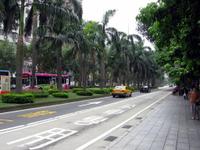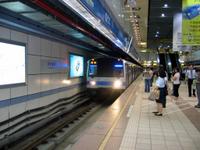 So few of you will venture there, so I find this project possibly devoid of audience. Then again, you should go check it out, because it really is quite a city to visit...especially if you love night life and amazing food, the latter I'll discuss in a later post.
So few of you will venture there, so I find this project possibly devoid of audience. Then again, you should go check it out, because it really is quite a city to visit...especially if you love night life and amazing food, the latter I'll discuss in a later post.Self-directed vehicles (namely: you drive your own car, ride your own scooter or bike):
 Despite my relative success traversing the lawless streets of Taipei in my dad's Nissan Cefiro, this is a highly not recommended mode of transportation. Not only do you need fine control of your vehicle, you need New Yorkeresque tough/rudeness to jostle for your right of way. And watch out for other calvaries; chances are they are more daring than you are. That said, I did witness two foreigners bike to a little diner, so go for it if you're into a little adventure. Just remember to wear a helmet on a scooter or a bike because the cops are not very negotiable.
Despite my relative success traversing the lawless streets of Taipei in my dad's Nissan Cefiro, this is a highly not recommended mode of transportation. Not only do you need fine control of your vehicle, you need New Yorkeresque tough/rudeness to jostle for your right of way. And watch out for other calvaries; chances are they are more daring than you are. That said, I did witness two foreigners bike to a little diner, so go for it if you're into a little adventure. Just remember to wear a helmet on a scooter or a bike because the cops are not very negotiable.Metro Taipei (MRT):
 A map and enough dough is all that you need to use this awesome system. Even better if you put money on an Easy Card and can thus effortlessly glide through the gates. The website tells all. The lines are, like the metro system in any other modern city, color-coded. The clean and comfortable trains carry you fast and smooth from one pleasantly modern station to the next, with audio and marquee reminders in Chinese dialects and English to guide your way. I find the recorded voice at times annoying and other times slightly arousing, but that's just me. This is undoubtedly the best way to get around Taipei, IMHO. The only downside is that the system is still partly under construction, and the outer parts of the city are not accessible by metro.
A map and enough dough is all that you need to use this awesome system. Even better if you put money on an Easy Card and can thus effortlessly glide through the gates. The website tells all. The lines are, like the metro system in any other modern city, color-coded. The clean and comfortable trains carry you fast and smooth from one pleasantly modern station to the next, with audio and marquee reminders in Chinese dialects and English to guide your way. I find the recorded voice at times annoying and other times slightly arousing, but that's just me. This is undoubtedly the best way to get around Taipei, IMHO. The only downside is that the system is still partly under construction, and the outer parts of the city are not accessible by metro.Bus:
Navigating the privatized bus system can be a daunting task for any foreigner. The lines have numerical names such as "287" or color-numerical names such as "Blue-36" (which means it will cross the metro lines of the same color at certain stations). Although bus stops are ubiquitous across the entire city, the ability to read Chinese is necessary to know which stop it is and where the bus lines are going. To add to the confusion, almost as a rule, several lines pass through the same stop, so it's much better to have someone tell you which stop to go to and which bus to get on rather than having to sort things out yourself. Things do get easier once you're on the bus, though. Most buses have Chinese and English marquees, some even have audio prompts in the said tongues. The Easy Card that saved you time on the metro will likewise help you out here. Avoid rush hour if you can; for one thing, the bus moves slower, and you'll build up good arm strength if you have to stand and grab onto the handles in mostly bumpy rides.
Taxi:
They are everywhere you want to be, if you want to pay. Hailing a yellow taxi is the same here as anywhere else, just raise your hand and someone will quickly pull up for your business. The drivers are courteous to you, rude to other drivers; in both cases, you win. This mode of transport is a bit pricier than others, and most likely English won't get you very far. Travel with a local friend, or have someone write down where you want to go. Keep a look out for some more stylish taxis; since the car modification ban was lifted, there have been some interesting additions to the fleets in Taipei.
Walking:
Only for the short gaps between mechanical modes of transport and your destination. Use sparingly.
Bon Voyage!
1 comment:
great post....keep it up...
Post a Comment